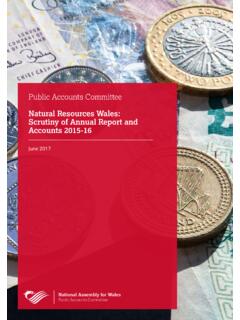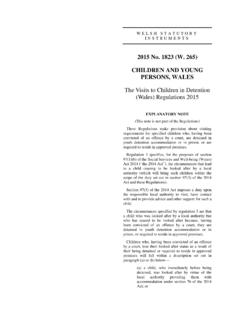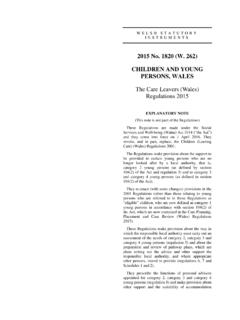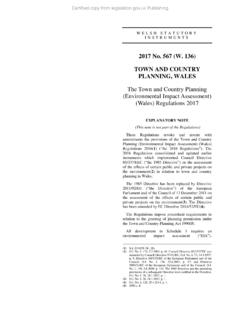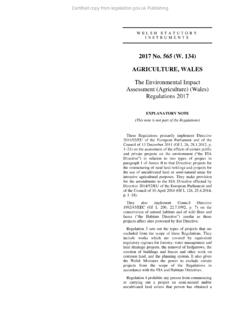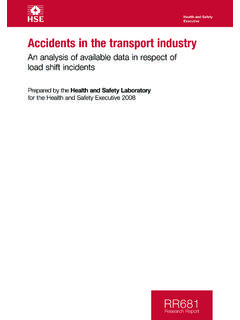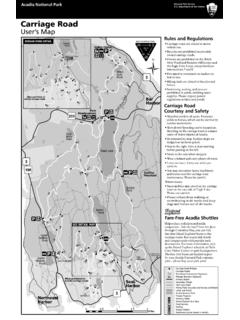Transcription of Rights of Way - National Assembly for Wales - Home
1 1 Rights of Way March 2011 April 2007 What are Assembly Measures? What is a Right of Way? A public right of way is a highway1 which anybody may use at any time. A right of way usually passes between two highways a right of passage between a road and a public footpath etc. Public Rights of way are usually signed at junctions with roads with a public path sign. A definitive map is kept by local highway authorities and is a legal record of the public's Rights of way in their area. If a way is shown on the map, then that is legal, or conclusive, evidence that the public had those Rights along the way at the relevant date of the map (and has them still, unless there has been a legally authorised change).
2 However, if paths are not shown on the definitive map it is not proof that the public has no Rights over it it could be that the map needs updating. 2 A private right of way is for an individual, or any group other than the public, to gain access to a particular feature to gain access to a house or a field. The Land Registry keeps a record of all registered land in England and Wales . Official Land Registry copies of Title Registers and Title Plans3 can be purchased from here. The Title Register contains a description of the property and other information but also refers to any Rights of way and other easements affecting the What are the different types of Public Rights of Way?
3 There are four types of public Rights of way in Wales which can be used in different ways, depending on the type: Footpaths - over which the right of way is on foot only. Of the public Rights of way in Wales 79 per cent are classed as footpaths. Bridleways - for walkers, horse riders and cyclists. This classification covers 15 per cent of public Rights of way in Wales . 1 There is no statutory definition of a highway, only a common law one. That definition is quite clear: a "highway is a way over which all members of the public have the right to pass and repass. Their use of the way must be as of right, not on sufferance or by licence".
4 2 The highway authority has a duty under the Countryside and Rights of Way Act 2000 to keep its definitive map up to date. 3 Title Register and Title Plans were historically called Title Deeds 4 Land Registry, Title Deeds, website [accessed 22 February 2011] Members Research Service: Quick guide Quick guide 2 Byways make up 6 per cent of the public Rights of way network and consist of: Byways open to all traffic (BOATs) - open to all traffic, including vehicles but which are mainly for the purposes for which footpaths and bridleways are used. Restricted byways these carry the Rights for all types of traffic except motorised vehicles.
5 5 Who is responsible for Public Rights of Way? Responsibility for keeping public Rights of way open is shared by highway authorities6 and the occupiers of land7. Under the Highways Act 19808 highway authorities have a duty to protect and maintain public Rights of way for public use. They also have a duty to prevent the obstruction or closing of any public Rights of way. If a person believes that the highway authority is failing in this duty, they can serve notice on the highway authority to request that the obstruction be removed. If the local authority fails to act, the individual serving the notice can seek a magistrates court order to require action.
6 Only certain types of obstructions are covered by these provisions. They only apply to footpaths, bridleways and restricted byways, and to ways shown on a definitive map as restricted byways or byways open to all traffic. Some local authorities have delegated their powers over Rights of way to National Park authorities and community councils. Community councils also have discretionary powers which enable them to maintain the footpaths or bridleways, and can require the highway authority to carry out its duty to remove obstructions. How can a Public Right of Way be changed? The Highways Act 1980 gives highway authorities the power to create, extinguish or divert a footpath or bridleway, normally by making a public path order.
7 Also the Town and Country Planning Act 1990 gives an authority the power to divert, extinguish or temporarily divert a footpath or bridleway in order to develop the land they are on. Extinguishment of a footpath or bridleway can only be achieved where it can be shown that there is no longer a need for the path. In deciding this, an authority must take into account how much the route is likely to be used by the public if it is not extinguished and the effect of the extinguishment on the land over which the route passes. Proposals to change the Rights of way network can arise from applications or requests made to the local authority (for example from local residents, path users, farmers or landowners) or the authority itself may propose to make a change.
8 9 Any objections made to a public path order must be relevant to the grounds upon which the order was made objections to an order for a public right of way to be extinguished 5 Countryside Council for Wales , Enjoying the Country, Public Rights of Way, website [accessed 21 February 2011] 6 In Wales , the 22 Unitary Authorities are the highway authorities (the Welsh Government is the highway authority for the Trunk Road Network). 7 The occupier is usually the tenant or the owner-occupier. 8 Highways Act 1980, (chapter 66) 9 Planning Inspectorate Wales , Rights of Way, webpage [accessed 21 February 2011] 3 must be made on the basis that the path is still in use by the public.
9 If no objections are made to the order then the local authority may confirm the order itself. If however, objections are made then the power to confirm the order is transferred to the Welsh Government for determination. In most cases investigation into the order will be completed by the Planning Inspectorate10 who will report to the Welsh Government. The Planning Inspector may review any objections by holding a public inquiry, by holding a hearing or by written correspondence. What are the different types of Private Rights of Way? A private right of way is for an individual, or any group other than the public, to gain access to a particular feature, to gain access to a house or a field.
10 Private Rights of way may exist in a variety of forms, namely through a licence, mere equities or an easement. Licences and mere equities Under the terms of a licence, a landowner may grant particular persons permission to enter his/her land for specified purposes. Generally, licences are revocable by the grantor although, in certain circumstances, the courts may recognise and enforce irrevocable licences linked to proprietary interests until the purpose for which the licence was given has been fulfilled ( builders allowed onto a neighbour s land during building work). The courts have recognised a wide variety of proprietary and quasi-proprietary Rights and interests in or over land, which can be enforced through the principles of equity11.


